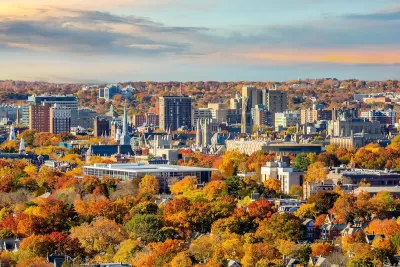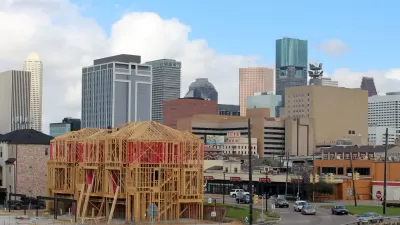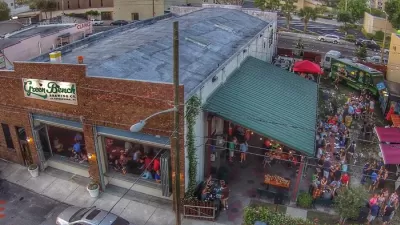Seeking recovery from decades of failed urban renewal projects, New Haven rings in the new year by continuing a series of small-scale urban planning initiatives to reinvent its municipal spaces.

As the cultural capital of Connecticut, New Haven begins the new year by pursuing several small-scale urban planning initiatives to reinvigorate its areas lost to urban renewal.
Heavily impacted by the overambitious urbanization of American cities in the 1950s-1960s, New Haven is still recuperating from the effects of the interstate highway system, including the demolition of local neighbourhoods and uncompleted roadway construction.
According to Jared Brey, a senior reporter at Governing, “there are now efforts underway all around New Haven to reshape its character. It’s plain to city planners today that tearing down dense housing in downtowns to make room for highways was a bad idea. Incremental, small-scale development is what gave the densest parts of New Haven and other cities their identity. Cities in general are now clamoring for more housing and trying to mitigate the impacts of air pollution and greenhouse gas emissions caused by highways.”
In response to previous urban renewal efforts, the city continues implementing its two-decade project “Downtown Crossing,” which aims to reinvent the uncompleted Route 34 Oak Street connector highway. This small-scale reinvention entails designing pedestrian crossings over top of the highway, to connect previously destroyed neighbourhoods with the downtown area.
Brey highlights the destructive history of the Route 34 Oak Street connector highway: “countless cities were reconfigured by the interstate highway and urban renewal programs of the mid-20th century, but few were altered as profoundly as New Haven. The center of the city was bulldozed to build portions of I-95, I-91 and the Oak Street Connector, the stretch of highway that was never finished. Blocks of tightly knit homes and businesses — slums in the parlance of the day — were cleared for new housing, roads and parking ... the Oak Street project alone displaced more than 880 families and 350 businesses.”
Despite Downtown Crossing's urban planning initiatives to repair the wreckage of Route 34 Oak Street Connector Highway, its main objective concentrates on rejuvenating the true character of the city. This entails the incorporation of new bicycle lanes, protected spaces for pedestrians, and native green infrastructure, which is meant to provide a sense of united locality and community fellowship.
Justin Elicker, the Mayor of New Haven, sheds light on the project: “in the past, there was so much focus on using cars to facilitate people living in a single-family house in the suburbs, and over time, people have realized that doesn’t necessarily provide the best opportunities for someone to be a whole person ... this project is one example of creating spaces where people will choose to be, that make people better people by facilitating interactions.”
However, according to Alan Plattus, the founding director of “Yale Urban Design Workshop”, rectifying the aftermath of failed urban renewal projects may further contribute to the issue: “one of my classic examples of how the damage never totally goes away is that the dimensions of the original Route 34 have been reproduced in the footprints of the so-called repair projects.”
Although met with constructive criticism, New Haven’s Downtown Crossing is committed to revitalizing its damaged areas and local neighbourhoods. Only time will tell how effective such urban planning initiatives will be, and whether present restoration efforts can outweigh the cost of unfinished urban renewal.

Alabama: Trump Terminates Settlements for Black Communities Harmed By Raw Sewage
Trump deemed the landmark civil rights agreement “illegal DEI and environmental justice policy.”

Study: Maui’s Plan to Convert Vacation Rentals to Long-Term Housing Could Cause Nearly $1 Billion Economic Loss
The plan would reduce visitor accommodation by 25% resulting in 1,900 jobs lost.

Why Should We Subsidize Public Transportation?
Many public transit agencies face financial stress due to rising costs, declining fare revenue, and declining subsidies. Transit advocates must provide a strong business case for increasing public transit funding.

Paris Bike Boom Leads to Steep Drop in Air Pollution
The French city’s air quality has improved dramatically in the past 20 years, coinciding with a growth in cycling.

Why Housing Costs More to Build in California Than in Texas
Hard costs like labor and materials combined with ‘soft’ costs such as permitting make building in the San Francisco Bay Area almost three times as costly as in Texas cities.

San Diego County Sees a Rise in Urban Coyotes
San Diego County experiences a rise in urban coyotes, as sightings become prevalent throughout its urban neighbourhoods and surrounding areas.
Urban Design for Planners 1: Software Tools
This six-course series explores essential urban design concepts using open source software and equips planners with the tools they need to participate fully in the urban design process.
Planning for Universal Design
Learn the tools for implementing Universal Design in planning regulations.
Smith Gee Studio
Alamo Area Metropolitan Planning Organization
City of Santa Clarita
Institute for Housing and Urban Development Studies (IHS)
City of Grandview
Harvard GSD Executive Education
Toledo-Lucas County Plan Commissions
Salt Lake City
NYU Wagner Graduate School of Public Service




























